When most of the garden sleeps under winter’s gray, a few bright blossoms refuse to stay hidden.
Winter jasmine (Jasminum nudiflorum) is one of the few plants that dares to bloom in the coldest months, spilling cheerful color across bare walls, stone terraces, or snowy slopes.
Unlike its fragrant cousins, this jasmine variety offers no scent, but its hardiness and golden blossoms make it a garden favorite.
Gardeners seeking other hardy winter plants can explore our list of tough winter flowers.
In this article, you’ll learn everything you need to know to grow, prune, and care for winter jasmine so it thrives year after year.
What Is Winter Jasmine? (Jasminum nudiflorum Explained)
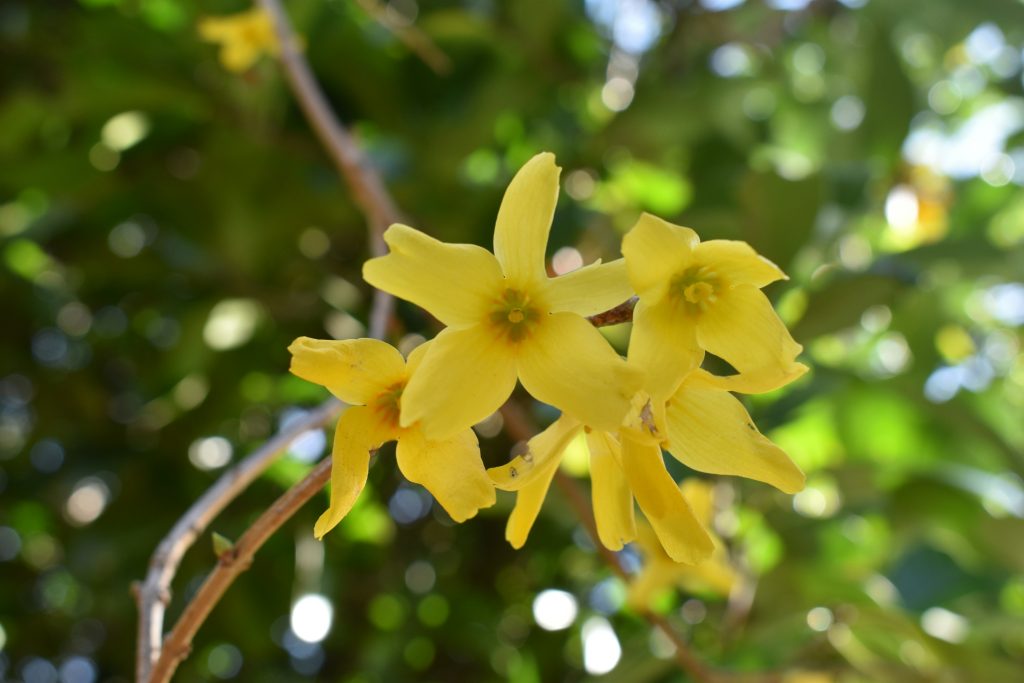
Winter jasmine is a dependable shrub that brings a burst of color when the garden is otherwise bare.
Its slender, arching stems carry bright yellow flowers in the cold months, often appearing as early as January.
Unlike many jasmines, it doesn’t twine or climb on its own, but with support, it can be trained to cover walls, trellises, or fences. Its green stems remain attractive year-round, even after flowering.
Originating from China, where it is cherished as the “flower that welcomes spring,” winter jasmine stands out as the most cold-hardy member of the jasmine family.
It’s not fragrant, but its resilience, adaptability, and early blooms make it a favorite for gardeners who want low-maintenance winter interest.
| Feature | Details |
|---|---|
| Botanical Name | Jasminum nudiflorum |
| Common Name | Winter Jasmine |
| Origin | China (Yingchun = “flower that welcomes spring”) |
| Plant Type | Deciduous to semi-evergreen shrub |
| Flower Color | Bright yellow |
| Bloom Time | Late winter to early spring (often Jan–March) |
| Fragrance | None |
| Growth Habit | Arching stems; can trail, cascade, or be trained to climb with support |
| Height & Spread | Typically 3–4 ft tall, up to 7–10 ft wide with support |
| Hardiness | USDA Zones 6–10 (most cold-hardy jasmine) |
| Maintenance | Low; thrives in poor soils, minimal fertilizer needs |
Best Location to Plant Winter Jasmine

Finding the right spot for winter jasmine is the first step toward healthy growth and abundant blooms.
While this shrub is adaptable, choosing an ideal location will help it thrive with very little effort.
Sunlight Requirements
Winter jasmine thrives in full sun, where it produces the most vibrant and abundant flowers. It will grow in partial shade, but the display is often less impressive.
For the brightest winter color, choose a spot that gets at least six hours of direct sunlight each day.
Soil Conditions
This shrub is adaptable and will tolerate a range of soils, including clay and sandy ground. The key is good drainage – winter jasmine dislikes standing water.
If your soil is heavy, consider adding compost (learn more about the Berkeley method of composting) or planting on a slight slope to encourage runoff.
Ideal Placement in the Garden
Winter jasmine looks its best when given space to sprawl or cascade. Choose a site where its arching stems can be shown off:
- Against a wall or fence that needs softening
- At the top of a terrace or stone wall, where it can spill downward
- On banks or slopes, where it provides both coverage and erosion control
By selecting the right location – sunny, well-drained, and spacious – you set the stage for a low-maintenance shrub that will brighten the garden in the coldest months.
How to Plant Winter Jasmine Step by Step
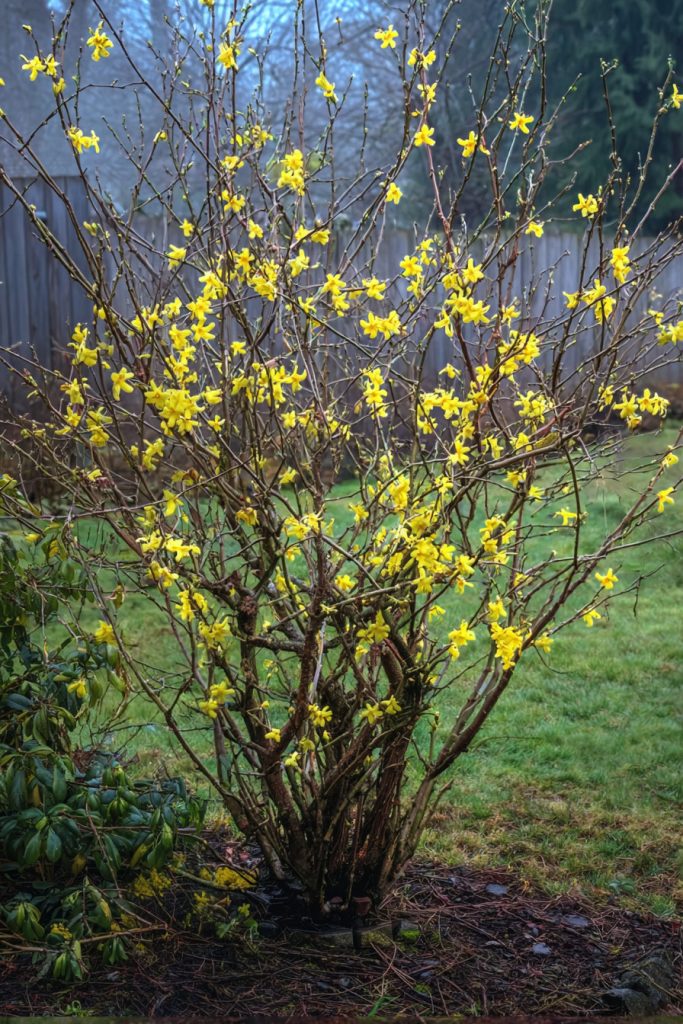
Winter jasmine is rarely grown from seed. Most gardeners start with a nursery-grown plant in a pot or a rooted cutting.
Planting an established shrub gives you a healthy start and ensures quicker blooms. With careful planting, your winter jasmine will reward you with years of bright winter color.
Here’s a detailed, step-by-step guide for planting a young winter jasmine shrub:
Step 1: Choose the Right Planting Time
The best seasons to plant a nursery-grown winter jasmine are early spring or fall, when temperatures are mild and rainfall is usually more reliable.
This timing allows the plant to settle its roots before summer heat or winter freezes.
If you live in a colder climate, spring planting is ideal because it gives the shrub a full growing season to become established before facing its first winter.
Step 2: Pick the Spot and Mark Spacing
As I mentioned earlier, winter jasmine needs at least six hours of sun per day to bloom well, though it will tolerate light shade. Choose a bright, open spot where it can stretch and spill naturally.
If you’re planting more than one shrub, mark spots about 3 to 5 feet apart.
This spacing ensures each plant has enough room to develop its arching habit without crowding its neighbors, and it creates good airflow around the stems.
Step 3: Prepare the Soil and Dig the Hole
This plant is forgiving of poor soils, but it will get off to a stronger start if you take a few minutes to prepare the site.
Loosen the soil to a depth of 8–12 inches, breaking up clumps so roots can spread easily.
Mix in a shovelful or two of compost to add organic matter, especially if the soil is heavy clay or very sandy (see our guide on how to compost for beginners).
Dig a hole twice as wide as the root ball – this gives new roots soft soil to grow into – but keep it only as deep as the root ball’s height so the plant sits at the correct level.
Step 4: Hydrate and Loosen the Roots
Before planting, water the shrub thoroughly in its container to reduce transplant shock.
When removing it, gently loosen any circling roots at the edges of the root ball.
Roots that spiral inside a pot can continue to circle if left untouched, which may restrict growth later. Spreading them outward encourages the plant to anchor itself quickly in its new home.
Step 5: Set the Plant at the Correct Depth
Place the shrub in the hole so the crown (where stems meet roots) is level with the soil surface.
Setting it too deep can smother the plant, while planting it too high can expose roots.
As you backfill with soil, press gently but firmly around the root ball to eliminate air pockets, which can dry out roots.
Step 6: Water Deeply to Settle Soil
Give the newly planted shrub a long, slow watering until the soil is saturated to the full depth of the hole. This helps the soil settle firmly around the roots.
If you notice any depressions forming, top them off with a little extra soil so water doesn’t collect and cause rot. Consistent moisture in the first growing season is the key to strong establishment.
Step 7: Mulch Properly
Spread 2–3 inches of mulch over the soil surface around the base of the shrub. Mulch helps conserve soil moisture, reduces weed competition, and provides insulation against temperature swings.
Keep it 2–3 inches away from the stems to prevent fungal rot or insect damage. Good mulch choices include shredded bark, leaf mold, or composted wood chips.
To get the most from wood chips and improve your soil, check out our guide on practical ways to use wood chips.
Training Winter Jasmine to Climb or Trail

Winter jasmine is not a natural climber like ivy or clematis. Instead, it produces long, arching stems that will scramble along the ground unless you guide them.
With a little help, you can decide whether to train it upward for height or allow it to trail for a softer, cascading effect.
Encouraging Vertical Growth
If you’d like winter jasmine to climb, it will need support. A trellis, wall wires, or a sturdy fence are excellent choices.
Install supports at planting time or as early as possible, since adding them later can disturb roots. As the stems lengthen, gently tie them to the support with soft garden ties or twine.
Secure them loosely to prevent damage as they thicken. Over time, the plant will create a leafy, flower-covered screen.
For ideas on using trellises to enhance privacy, see trellis ideas for privacy.
Promoting a Central Leader
To achieve a more upright, tidy form, select one or two strong stems to act as the main leaders.
Remove side shoots from the lower portions of these stems while they are still young.
This directs energy into upward growth, creating a more structured look. The side shoots higher up can be left in place to fill in and provide blooms.
Letting Winter Jasmine Trail and Spill
For a natural, informal look, allow winter jasmine to trail.
Its stems will spill gracefully over retaining walls, terraces, or raised beds, softening edges with flowing greenery and golden flowers.
When planted at the top of a slope, it can cascade down like a living waterfall, providing beauty while also stabilizing soil and reducing erosion.
Groundcover on Slopes and Banks
If allowed to sprawl freely, winter jasmine makes an effective groundcover. Its stems root easily where they touch the soil, helping to cover bare patches and hold soil in place on banks.
This makes it a smart choice for problem areas where grass struggles to grow or where erosion is a concern.
For ideas on plants you can eat while still covering the ground, see our guide to edible ground covers.
Tip: Winter jasmine is easier to shape when it’s young and flexible. Start guiding its growth during the first few seasons, and you’ll establish the form you want with much less effort than trying to redirect it later.
Winter Jasmine Watering and Fertilizer Guide
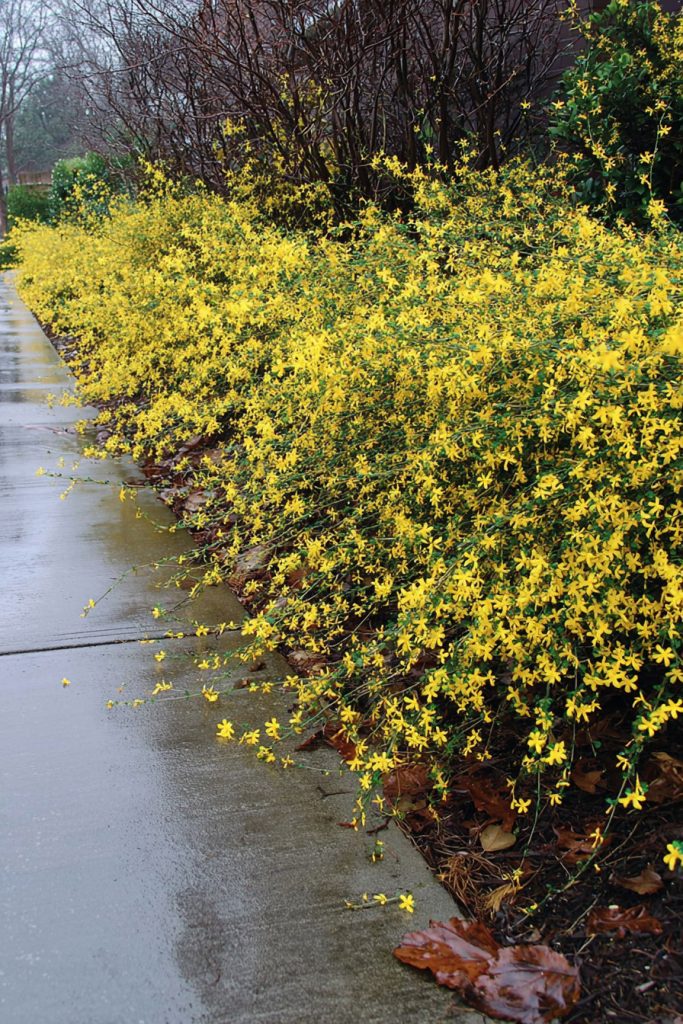
Winter jasmine is low-maintenance once established, but a little attention to watering and feeding during its early years will keep it healthy and blooming.
Watering Newly Planted Winter Jasmine
During the first growing season, water regularly to help roots establish. Aim for deep watering once a week, soaking the soil so moisture reaches the root zone.
Shallow, frequent watering encourages surface roots, which are less resilient during heat or drought.
Always adjust based on weather – watering more often during hot, dry spells and less when rainfall is plentiful.
Watering Established Plants
Once established, winter jasmine is remarkably drought-tolerant. In most regions, natural rainfall will be enough.
However, in extended dry periods, an occasional deep soak will keep the plant looking fresh and support steady flowering. Avoid overwatering, as constantly soggy soil can cause root rot.
Fertilizer Needs Are Minimal
Winter jasmine is not a heavy feeder and often grows well without fertilizer. Too much fertilizer can lead to vigorous leafy growth at the expense of flowers.
Use Compost Instead of Chemicals
Instead of synthetic fertilizer, apply a layer of compost or well-rotted manure around the base of the plant once a year.
This improves soil texture, feeds beneficial organisms, and provides a slow, steady supply of nutrients. Add compost in spring as new growth begins, or in fall to enrich the soil before winter.
Mulch for Extra Soil Health
A 2–3 inch layer of organic mulch (like shredded bark or leaf mold) helps conserve moisture, reduce weeds, and gradually enrich the soil as it breaks down.
Keep mulch a few inches away from the stems to prevent rot. Using mulch effectively can also improve overall garden health – explore practical mulch garden ideas.
By keeping watering deep but infrequent and relying on compost rather than chemical fertilizers, you’ll maintain a hardy, low-maintenance shrub that rewards you with reliable winter blooms.
6 Steps on How to Propagate Winter Jasmine (Easy Layering Method)
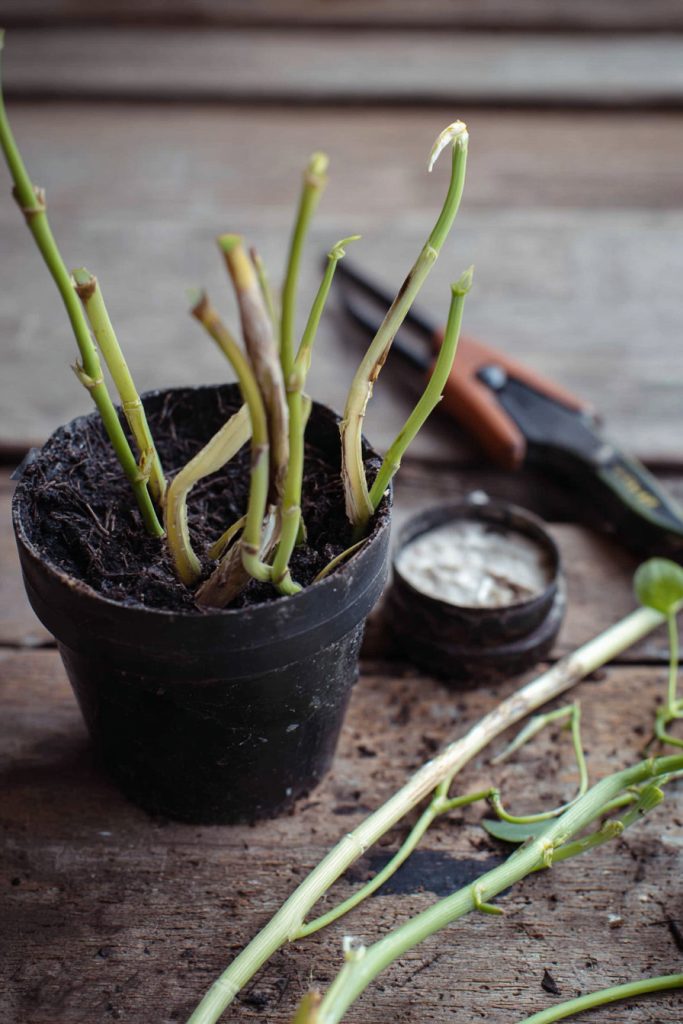
One of the easiest ways to expand your winter jasmine collection is through layering.
This method works with the plant’s natural growth habit, as its long, arching stems will often root when they touch the ground.
Unlike cuttings, layering keeps the stem attached to the parent plant until roots form, giving it a reliable supply of nutrients.
Step 1: Select a Healthy, Flexible Stem
Choose a long, low-growing branch that can easily be bent to touch the soil. Look for a stem that is healthy, green, and free from pests or damage, as this will give your new plant the strongest start.
Step 2: Prepare the Contact Point
On the section of stem that will touch the soil, remove a few leaves and make a shallow cut or scrape on the underside of the stem. This small wound encourages root formation by exposing inner tissues.
Step 3: Pin the Stem to the Soil
Bend the stem gently so the wounded section rests against the ground.
Secure it in place using a U-shaped piece of wire, a landscape pin, or even a small rock or brick. The key is to keep the stem in firm contact with the soil so roots can form.
Step 4: Keep the Area Moist
Water the area lightly to keep the soil moist but not soggy. Consistent moisture speeds up rooting. A thin layer of mulch can help retain soil moisture and protect the area from drying out.
Step 5: Wait for Roots to Develop
Within a few weeks to a few months – depending on the season and growing conditions – the pinned section will form roots.
You can check by gently tugging; resistance usually means roots have anchored into the soil.
Step 6: Separate and Transplant the New Plant
Once a good root system has formed, cut the stem free from the parent plant.
Carefully dig up the rooted section, keeping the new roots intact, and transplant it to its permanent location. Water well after transplanting to help it settle in.
Propagation by layering is almost foolproof, making it a great method for beginner gardeners.
With patience, you can multiply your plants and enjoy even more golden winter color throughout your garden.
How and When to Prune Winter Jasmine
Winter jasmine has a naturally arching, free-flowing shape, but without occasional pruning it can become messy or produce fewer flowers.
The key is knowing when to prune and how much to cut back for healthy growth.
When to Prune Winter Jasmine
Best time: Prune in early spring, right after the flowers fade. This timing is important because winter jasmine blooms on the previous year’s growth. If you prune too early, you’ll remove the buds before they flower.
Frequency: Light pruning can be done annually, while heavier pruning is only needed every few years.
Light Pruning for Shape and Maintenance
Each spring, after flowering:
- Remove old, woody stems that have turned brown. These are less productive and can be replaced with new growth.
- Thin out overcrowded areas to improve airflow and let light reach the inner stems.
- Trim back long, straggly stems to maintain shape, especially if they’re sprawling beyond their space.
This keeps the plant neat, encourages fresh green growth, and ensures a steady supply of blooms each winter.
Rejuvenation Pruning for Overgrown Plants
If your winter jasmine is overgrown, tangled, or producing very few flowers, it may need a harder cutback:
- In early spring, cut stems down to within 6–24 inches of the ground (depending on how severe the overgrowth is).
- New shoots will sprout from the base, forming a tighter, bushier shrub.
- Be patient – after such heavy pruning, it may take two to three years before the plant flowers fully again.
This “reset” pruning breathes new life into an old, tired shrub.
Tips for Successful Pruning
- Always use sharp, clean pruners to make clean cuts and reduce the risk of disease (check out our recommended pruners in essential gardening tools).
- Cut stems at an angle just above a leaf node to encourage healthy regrowth.
- Remove any dead or damaged branches as you see them, regardless of the season.
With the right approach, pruning keeps winter jasmine fresh, full, and bursting with bright yellow flowers when the rest of the garden still sleeps.
Winter Jasmine Pests and Common Problems
One of the reasons gardeners love winter jasmine is its resilience.
It rarely suffers from serious pests or diseases, making it a low-maintenance choice for most landscapes. Still, there are a few minor issues you may encounter.
Aphids on New Growth
What to Look For: Clusters of small, soft-bodied insects on young stems or the undersides of leaves. They may cause slight curling of new growth.
Management: Aphids usually aren’t a problem because natural predators – like ladybugs and birds – keep them in check.
If colonies get heavy, rinse them off with a strong spray of water or pinch affected tips. Avoid harsh chemical sprays, which can harm beneficial insects.
You can also explore effective ways to get rid of aphids naturally for more strategies.
Mealybugs on Stems
What to Look For: White, cotton-like patches tucked along stems or leaf joints.
Management: Mealybugs can be wiped away with a damp cloth or a cotton swab dipped in diluted rubbing alcohol. For larger infestations, prune out the worst-affected stems.
Fungal Concerns
What to Look For: Overly wet conditions may encourage root rot or mildew.
Management: The best prevention is well-drained soil and avoiding overwatering. Planting in the right location (sunny, airy, and never waterlogged) greatly reduces risk.
Environmental Stress
Yellowing Leaves: Often a sign of waterlogged soil or poor drainage.
Sparse Flowers: Usually caused by too much shade or improper pruning (cutting at the wrong time of year).
Winter Jasmine Is Low Risk
Compared with many other shrubs, winter jasmine is refreshingly easygoing.
It resists most pests naturally, needs little intervention, and rarely suffers from diseases if planted in a sunny, well-drained spot.
For organic gardeners, it’s a perfect choice – no sprays or treatments required.
5 Garden Design Ideas With Winter Jasmine
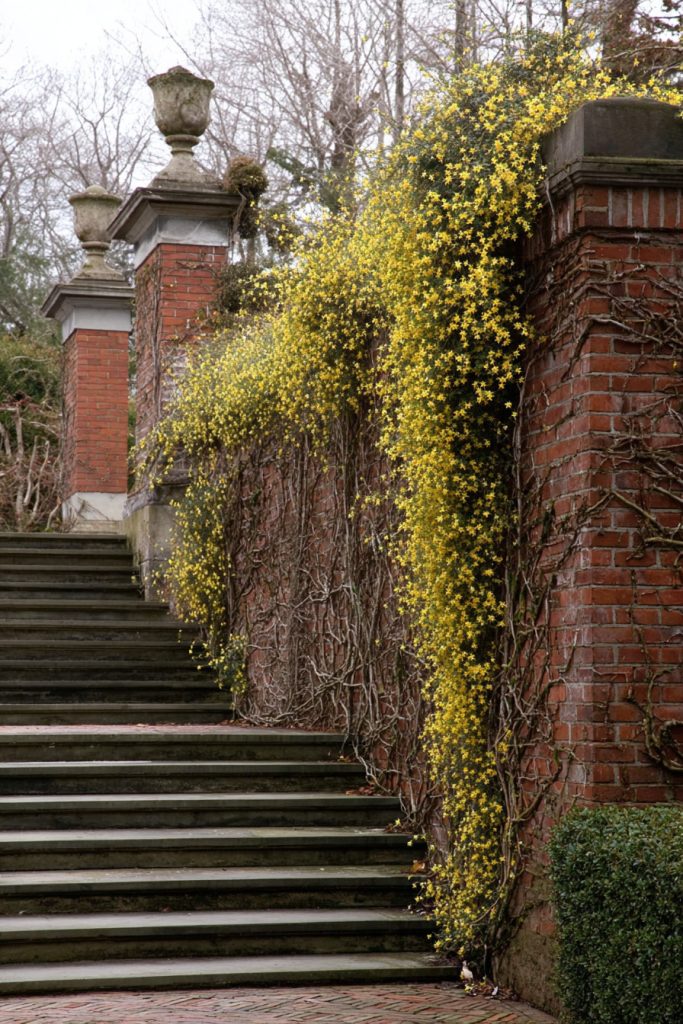
Winter jasmine shines when used thoughtfully in the garden. Beyond its practical uses, it can be a design element that brings color, texture, and seasonal interest.
1. Golden Cascade Over a Retaining Wall
- Plant winter jasmine at the top edge of a stone or brick retaining wall.
- Allow the arching stems to spill down naturally, creating a living waterfall of yellow blooms in winter.
- Underplant the wall base with evergreen groundcovers (like ivy or pachysandra) for a layered effect.
2. Winter Jasmine as a Living Fence Cover
- Install a wire trellis or lattice panel against a plain fence.
- Train jasmine stems upward with soft ties, letting them branch out to form a soft green-and-yellow screen.
- Combine with climbing clematis for summer flowers, so the fence looks lively across multiple seasons.
3. Pathway Accent With Seasonal Color
- Plant jasmine along one side of a garden path or walkway.
- Use short supports or stakes to guide stems upright, while allowing some to arch outward for a natural look.
- Pair with early bulbs like snowdrops and crocuses, so visitors walk through a burst of late-winter color.
4. Groundcover for Sloping Banks
- On sloped ground, plant jasmine in staggered rows 4–5 feet apart.
- Let the stems sprawl and root into the soil, forming a dense green mat that prevents erosion.
- Mix with ornamental grasses or low conifers at the top for year-round structure.
5. Archway or Pergola Highlight
- Train winter jasmine on a garden arch or small pergola near an entryway.
- Secure stems to the structure as they grow, creating a frame of yellow flowers in the cold months.
- Underplant with hellebores or evergreen ferns to fill out the base with texture.
These design recipes show how winter jasmine can function as more than just a filler shrub – it becomes an intentional part of the garden’s architecture and seasonal display.
For more inspiration, check out our beautiful garden design ideas that highlight creative ways to use plants throughout the year.
Why You Should Add Winter Jasmine to Your Garden
Winter jasmine might not fill the air with fragrance like its tropical relatives, but it has its own wintertime charm.
Its bright golden flowers light up the dullest months, it’s tough enough to thrive where many plants would fail, and it requires very little care.
Whether you let it spill gracefully over a stone wall, blanket a slope, or brighten a doorway, this resilient shrub brings dependable beauty and cheer to your garden with almost no effort.
If you’re looking for a plant that rewards you year after year with color when you need it most, winter jasmine is a worthy addition to your garden.
Have you grown winter jasmine before, or are you thinking about adding it to your space? Share your thoughts or questions in the comments below – I’d love to hear from you!
FAQs
1. Can winter jasmine be grown in pots or containers?
Yes, winter jasmine can grow in large containers if given support, regular watering, and fresh compost each year. Keep in mind it may not spread as freely as it does in the ground.
2. How fast does winter jasmine grow?
Winter jasmine grows at a moderate pace, usually adding 12–24 inches per year. With support, it can spread 7–10 feet wide over time.
3. Is winter jasmine evergreen or deciduous?
Winter jasmine is semi-evergreen. In warmer zones, it often keeps its green stems year-round, while in colder areas it may lose more leaves but still shows bright green stems.
4. Can winter jasmine survive snow and frost?
Yes. As the most cold-hardy jasmine, it tolerates temperatures down to USDA zone 6. Flowers may be nipped by very hard frosts, but the shrub itself will survive and bloom again.
5. How long does winter jasmine live?
With minimal care, winter jasmine can live decades. Regular pruning to remove old stems and encourage new growth keeps it vigorous and blooming for many years.
Ready To Transform Your Garden?
Are you looking for the best way to layout your garden beds? Maybe you're feeling a bit stuck on how to make the most of your space?
We’ve got you covered! Check out our 101+ Garden Bed Layout Ideas for your next raised bed project. This guide is filled with creative and practical ideas that can help you design a garden that fits your style, whether you’re just starting out or have been gardening for years.
Get your copy today and get inspired to bring your gardening dreams to life.

